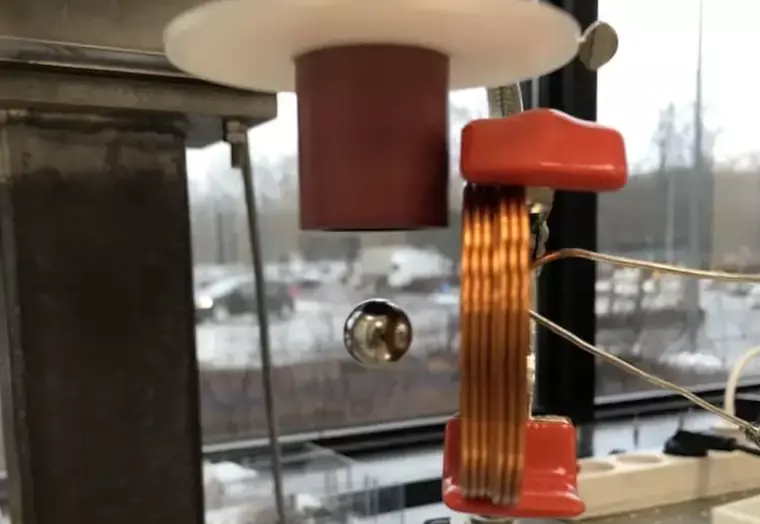In a groundbreaking discovery, scientists have unraveled an anti-gravity mystery that seemingly defied the norms of classical physics, potentially paving the way for revolutionary advancements in magnetic levitation technology.
The breakthrough centers on a unique form of magnetic levitation, first demonstrated in 2021 by Turkish scientist Hamdi Ucar, an electronics engineer from Göksal Aeronautics in Turkey.
Typically, the setup becomes unstable when you try to balance two repelling magnets to counter gravity. However, in a study featured in the journal Symmetry, Ucar revealed that when positioned close to another swiftly rotating magnet, a magnet can both spin and levitate in the air.
In his experiment, Ucar used a Levitron toy with a magnet attached to a motor spinning around 10,000 rpm. When positioned just a few centimeters beneath the swiftly spinning rotor, a second magnet also started to rotate and achieved a stable state of levitation.
Magnetic levitation isn’t a novel concept, with the most familiar example being Maglev trains. However, existing technologies use slow-spinning mechanics or external stabilizers to control the powerful magnetic forces used for lifting and propelling. In contrast, Ucar’s setup relied on high-speed rotation and a unique interaction between the rotating magnets.
The baffling behavior of the levitating magnets in Ucar’s experiments left researchers perplexed, as it appeared to go against the core principles of physics and the established norms of how magnets interact.
Intrigued by the scientific puzzle, Dr. Rasmus Bjørk and a team of researchers from the Technical University of Denmark embarked on a quest to demystify the unusual phenomenon.
“Magnets should not hover when they are close together. Usually, they will either attract or repel each other,” Dr. Bjørk explained. “But if you spin one of the magnets, it turns out, you can achieve this hovering. And that is the strange part. The force affecting the magnets should not change just because you rotate one of them, so it seems there is a coupling between the movement and the magnetic force.”
The researcher’s approach was twofold. The first involved replicating Ucar’s results using off-the-shelf items like neodymium magnets and power tools. In a second, more sophisticated experiment, the scientists used motion-tracking technology to take precise measurements of the
The findings were revelatory. Experiments showed that as the floater magnet began rotating, it locked in frequency with the rotor magnet, assuming a near-vertical orientation.
The polar axes of the two magnets, nearly perpendicular to each other, formed a configuration that would typically be unstable. However, in this setup, the spinning magnetic field of the rotor exerted a torque on the floater, locking it in a stable, levitated position.
Through computer modeling that considered the magnetostatic interactions between the two magnets, the research team says they solved the physics-defying anti-gravity mystery and confirmed the discovery of a new form of levitation.
In a paper published in Physical Review Applied, researchers detailed how the rotating magnet’s spinning field created a torque countered by the gyroscopic action of the levitating magnet’s rotation. This delicate balance of forces allowed for a stable levitation, with the magnetic forces creating both an attractive and a repulsive component, balancing the “floater” magnet in midair.
Rather than defying the laws of magnetostatics, the findings revealed that the equilibrium position of the levitating magnet is actually due to the magnetostatic interactions between the rotating magnet.
Dr. Bjørk explained the phenomenon is akin to a spinning top, where rotation locks the object in position, defying gravity or, in this case, the push and pull of magnetic forces.
Speaking with Physics Magazine, Ucar acknowledged the precision of the recent study and suggested further improvements in the simulations, particularly in accounting for the role of eddy currents. Meanwhile, Bjørk’s team concludes that these currents are negligible in this levitation mechanism.
In addition to solving a perplexing mystery, this newly understood interaction between magnetic forces could open the door to a world of possibilities in magnetic levitation technology.
Some experts, like Marcel Schuck, CEO and founder of No-Touch Robotics in Zurich, have already noted that a system using this newly discovered magnetic trapping and manipulation method could simplify and enhance existing magnetic levitation technologies.
“Other possibilities will depend on the extent to which the phenomenon can be up- or down-scaled and how low the energy cost will be,” study co-author and PhD candidate at DTU, Frederik Laust Durhuus, told Physics World. “This will require further investigation.”
Tim McMillan is a retired law enforcement executive, investigative reporter and co-founder of The Debrief. His writing typically focuses on defense, national security, the Intelligence Community and topics related to psychology. You can follow Tim on Twitter: @LtTimMcMillan. Tim can be reached by email: tim@thedebrief.org or through encrypted email: LtTimMcMillan@protonmail.com

